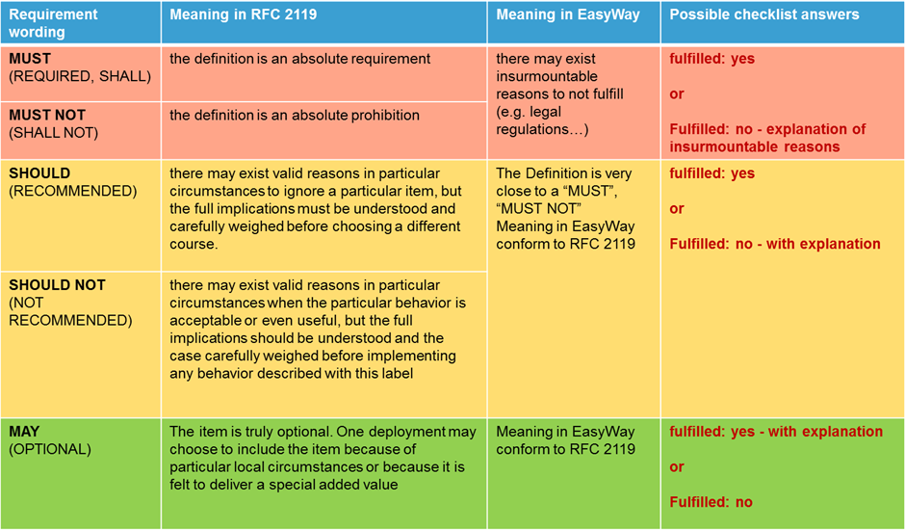It is essential for every prescriptive document to provide specifications in a well-defined and unambiguous language. There are various definitions that clarify the use of particular words (such as those listed below) within their prescriptive texts.
For the purpose of the ITS Deployment Guidelines, the well-established provisions of the RFC 2119 (http://www.ietf.org/rfc/rfc2119.txt, see (1)) are used, which is used to specify the basic Internet standards:
The key words „MUST“, „MUST NOT“, „REQUIRED“, „SHALL“, „SHALL NOT“, „SHOULD“, „SHOULD NOT“, „RECOMMENDED“, „MAY“, and „OPTIONAL“ in this document are to be interpreted as described in RFC 2119. An overview of the keywords, their meaning and the possible answers in the context of part A provides Table 2.
For the purpo

Table 2: Part A – requirement wording
In general, the keywords in brackets are possible, but their use is not recommended in order to avoid confusion which may arise because of different common linguistic usage of the terms in the different EU member states.
Note: the capitalisation of these keywords that is frequently used in Internet standards is not recommended for the ITS Deployment Guidelines.
The use of this ‚requirements language‘ allows the direct transfer of the requirements stated in part A to a compliance checklist.
The following paragraph gives an example for a functional requirement:
Functional requirement:
FR2: Data and information collected by both automatically and non-technical sources must be based upon both a consistent geographic reference model and a time validity model, which both must be part of data description.
Beneath “Requirement” a new semantic element “Advice” is proposed for part A, which has not the character of a hard requirement but of a “recommendation” and hence must not be listed in the compliance checklist. “Advice” is not immediately related to the three pillars of ITS-service harmonization (Interoperability, Common look & feel, Quality criteria) but to “inner features” of an ITS-service. Nevertheless, such an element delivers a European added value and hence should be addressed by the deployment guidelines.
The notation for using the advice element in the text is as follows:
Organisational advice:
Clear definitions of organisational aspects are a crucial precondition for the successful implementation of a „Forecast and real-time event information service“ and should be documented and accepted of all involved parties/partners in form of a Common partner arrangement/MoU – Memorandum of understanding, which establishes the details of co-operation.